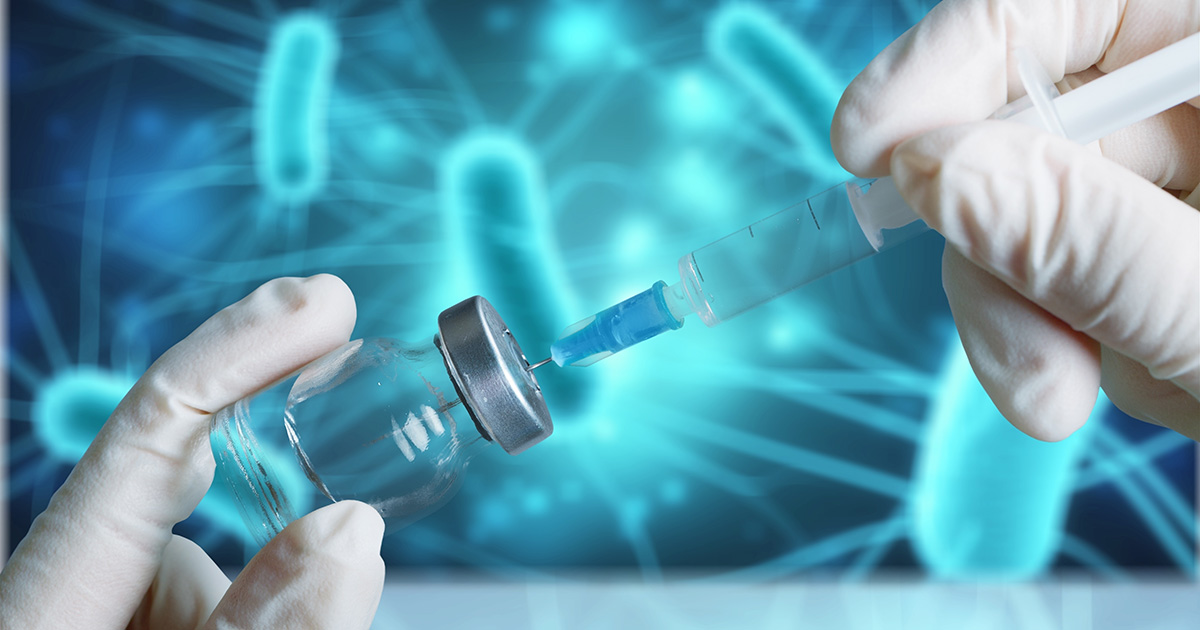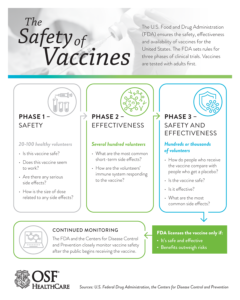
How to ensure that vaccines are safe
The United States has the safest vaccine supply in its history. And agencies like the U.S. Federal Drug Administration (FDA) and the Centers for Disease Control and Prevention (CDC) have established systems of clinical trials, monitoring and extended monitoring to ensure vaccines are as safe as possible.
This holds true for the vaccines under development for SARS-CoV-2, the virus that causes COVID-19.
These agencies have protocols to rapidly detect any problems rapidly and allow the agencies and companies developing vaccines to respond immediately.
Ensuring safety
 The FDA is charged with ensuring the safety, effectiveness and availability of vaccines for the U.S. Its team of scientists and the processes and systems it uses are considered the gold standard worldwide of vaccine evaluation, testing, approval and monitoring.
The FDA is charged with ensuring the safety, effectiveness and availability of vaccines for the U.S. Its team of scientists and the processes and systems it uses are considered the gold standard worldwide of vaccine evaluation, testing, approval and monitoring.
Before the FDA approves a vaccine, the vaccine is tested extensively by the manufacturer. FDA scientists and medical professionals then carefully evaluate all the available information about the vaccine to determine its safety and effectiveness.
“Part of the final release of a vaccine to the public is the evaluation of its safety,” said Sandy Salverson, PharmD, vice president of Pharmacy Operations for OSF HealthCare. “We know there will be some side effects related to the (COVID-19) vaccine. But, if there were severe side effects detected during the trials and further study, the FDA would not release the vaccine.”
Steps in the process
Once a manufacturer applies to the FDA for vaccine review, it is required to complete three phases of clinical trials. The first phase looks at the safety, followed by effectiveness in the second phase and safety and effectiveness together in the third phase. During each phase, the number of volunteer participants increases from a few hundred to several thousand.
After successfully completing all three phases, the FDA can approve the use of the vaccine. Following approval, the FDA continues to monitor the safety. During this monitoring phase, the FDA looks for possible side effects and adverse events that may not have shown up during the clinical trials.
If an unexpected adverse event occurs, according to the CDC, quick and further study is used to assess whether there is a true safety concern. “This monitoring,” the CDC states, “is critical to help ensure that the benefits continue to outweigh the risks for people who receive vaccines.”
Existing safety monitoring
The CDC and FDA have processes for monitoring the safety of vaccines. These include systems for collecting reports from health care professionals, vaccine manufacturers and the public about any adverse events; collaboration with health care organizations and medical research centers to further research adverse events; the use of data, analytics and innovation for real-time generation of information; and use of databases to monitor the safety of vaccines and other medical products.
Expanded safety monitoring
With the development of vaccines for COVID-19, the CDC and FDA have expanded its safety monitoring to allow the agencies to further evaluate the safety in real time.
This expanded safety monitoring includes:
- V-SAFE, a smartphone-based, after-vaccination health checker is for people who receive COVID-19 vaccines. It uses text messaging and web surveys from the CDC to check in with vaccine recipients following COVID-19 vaccination.
- National Healthcare Safety Network (NHSN) is the nation’s most widely used health care-associated infection tracking system. It provides the CDC data needed to identify issues and measure prevention efforts.
- FDA’s use of large insurer/payer databases, much like Medicare, to research claims-based data that apply to safety and adverse effects.
Veterans Affairs also has its own safety monitoring in place for veterans, as does the Department of Defense for members of the military and the Indian Health Service for tribal nations.
Meeting standards
As more people receive vaccines, health care organizations have a responsibility to report any adverse effects.
“Once the FDA determines a vaccine is safe based on their standards, then we, as a health care organization, have an obligation to report things unexpected,” Salverson said. “That will be a six- to nine-month requirement once the vaccine is on the market. Any unexpected side effects are reported to the FDA and the manufacturer of the vaccine.”
As Salverson has stated before, the overarching principle is that OSF is supportive of the use of vaccines.
“We believe they help prevent illnesses and keep our communities healthy,” she said. “We will evaluate the safety and efficacy of any COVID-19 vaccine just like we do with any other vaccine.”
